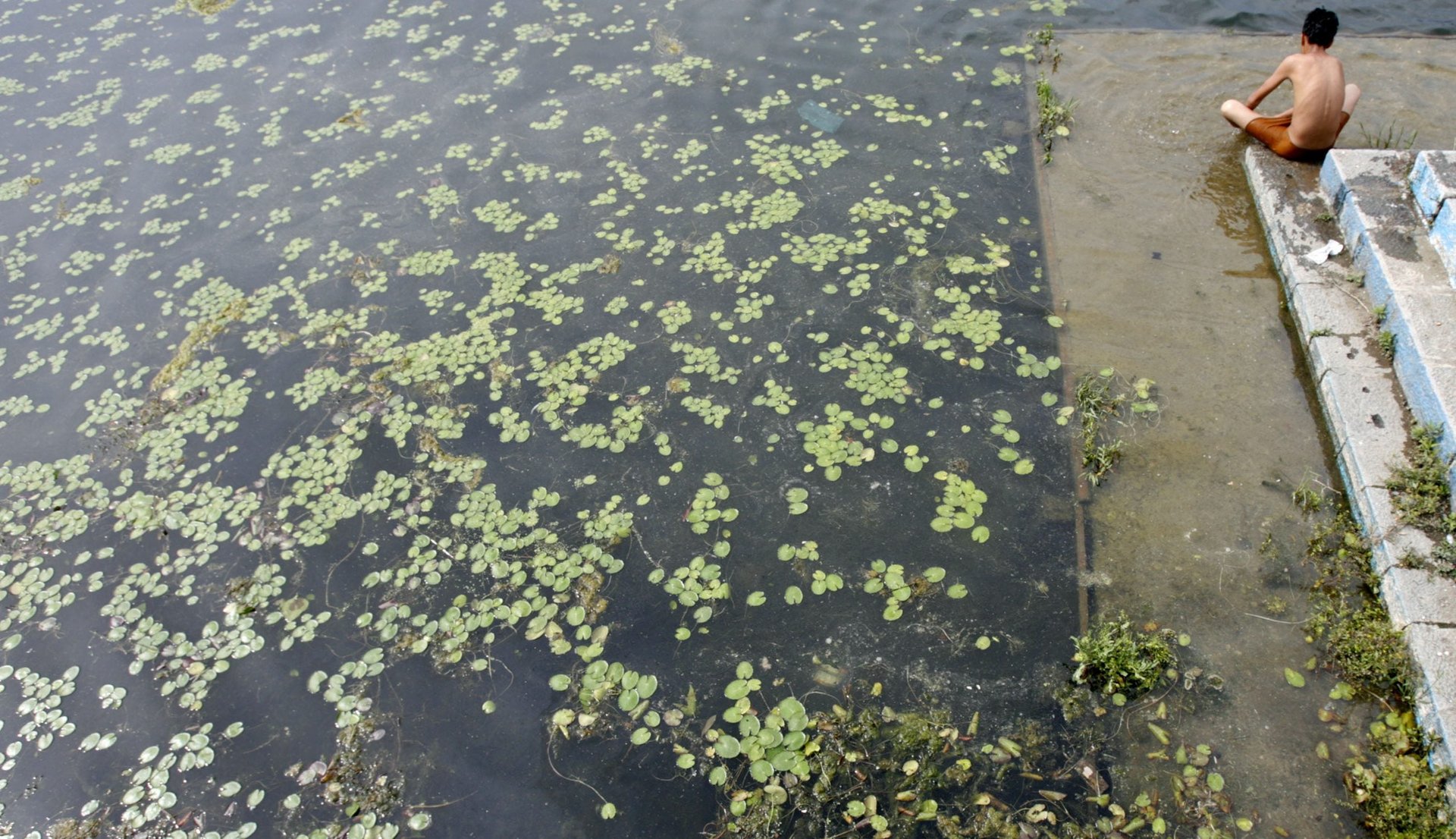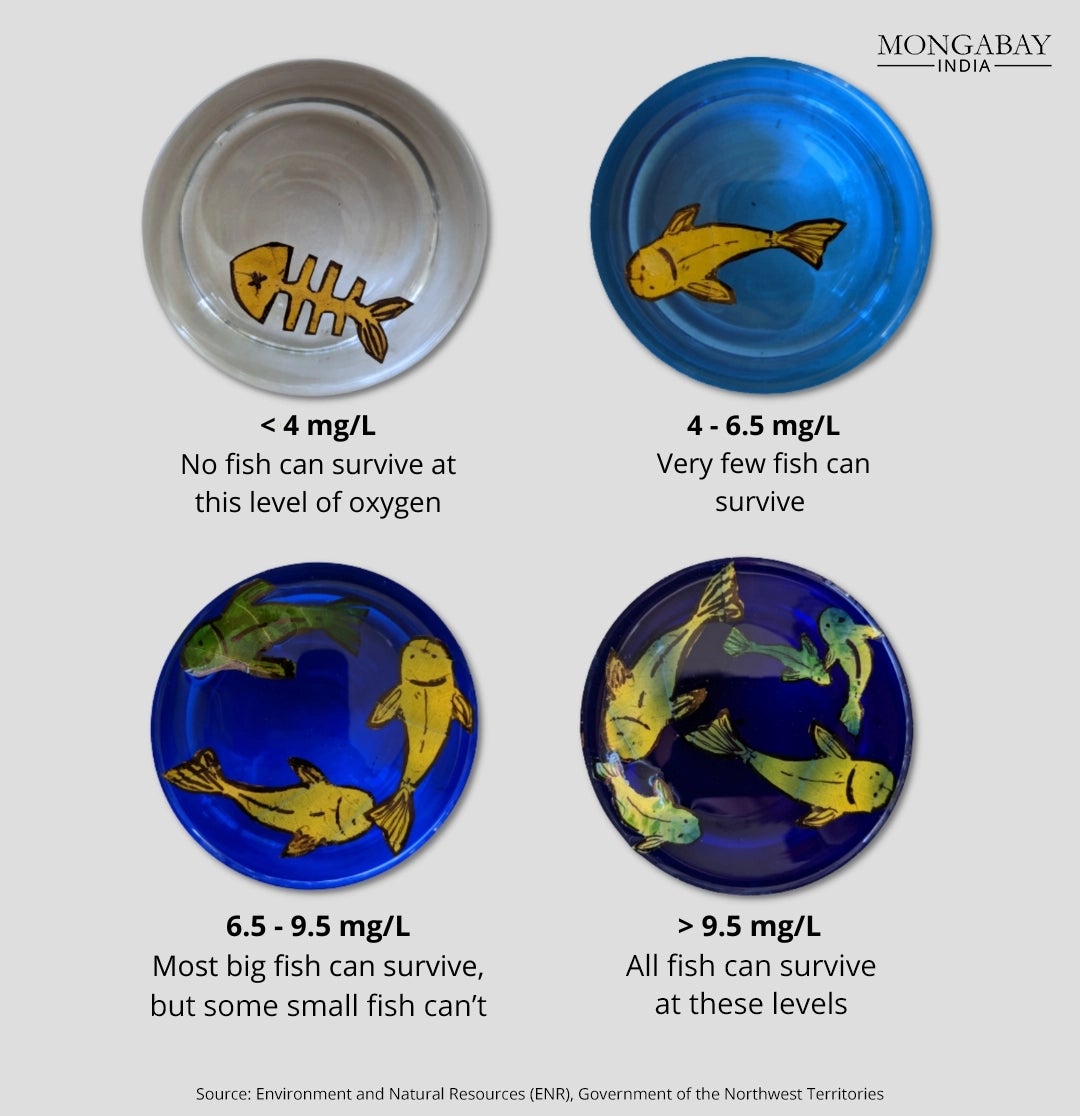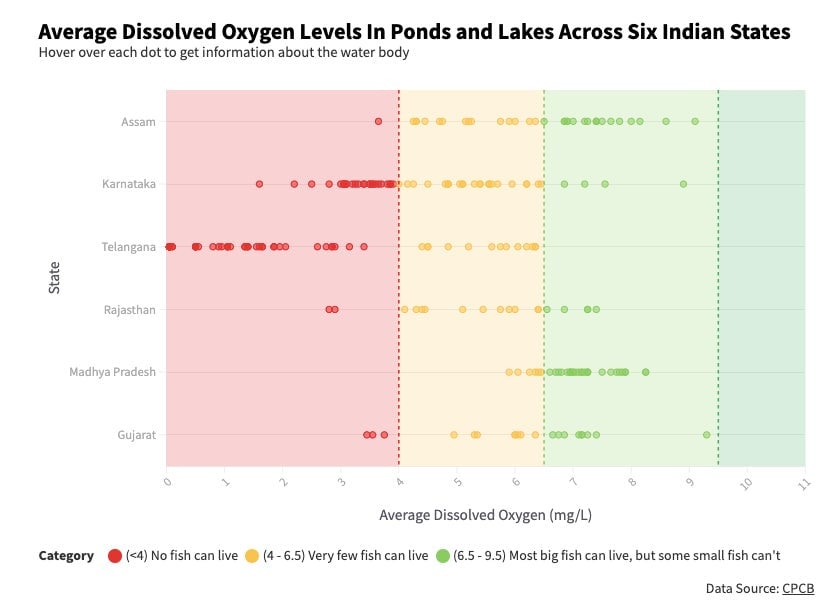India’s ponds and lakes are witnessing mass fish death
In April 2022, several images of dead fish floating in the Banganga tank, located in Mumbai’s Malabar Hill area, circulated on news sites and social media platforms. Clean-up efforts were initiated after locals observed the dead fish in the tank and informed the Brihanmumbai Municipal Corporation (BMC). The contractor appointed for the clean-up claimed that four trucks of fish were removed from the site. Officials speculated that the loss of oxygen was the likely cause of the mass fish deaths.


In April 2022, several images of dead fish floating in the Banganga tank, located in Mumbai’s Malabar Hill area, circulated on news sites and social media platforms. Clean-up efforts were initiated after locals observed the dead fish in the tank and informed the Brihanmumbai Municipal Corporation (BMC). The contractor appointed for the clean-up claimed that four trucks of fish were removed from the site. Officials speculated that the loss of oxygen was the likely cause of the mass fish deaths.
This is not the first time that such an incident has occurred. Mass fish death in the Banganga tank has been labelled an “annual tragedy” in previous years. One key cause that has been identified for the fish deaths is people putting large quantities of food in the water as part of religious rituals.
In a separate case, more recently, a huge number of fish were found dead in a five-kilometre upstream stretch of the Najafgarh drain along the Delhi-Haryana border. Initial reports speculate that these deaths could be because of fertiliser pollution in the river which causes algal blooms that in turn deplete the water of oxygen, killing aquatic life.
Numerous ponds, lakes and other water bodies across India have been sites of mass deaths of fish and other aquatic species. The chief cause of this phenomenon is water pollution, most often stemming from anthropogenic activities.
Why should we care about water pollution and fish deaths?
While urban dwellers might not immediately or directly experience the effects of mass fish deaths or polluted lakes, ponds and other water bodies, it is crucial to recognise one’s role in the issue and take responsibility.
“Without our rivers, lakes, ponds and other water bodies, India’s geography, language and culture would be very different. People are intertwined with these water bodies in material and spiritual ways. Water bodies are a crucial part of the culture of any civilisation,” points out Priya Ranganathan, a PhD scholar at the Ashoka Trust for Research in Ecology and the Environment who has worked on topics such as wetland ecology, community-based conservation and ecohydrological flows.
“When an aquatic ecosystem is adversely affected, local species are wiped out and this harms local livelihoods. Even if city dwellers do not interact with water bodies on a daily basis and may not immediately feel the effects of water pollution, it would be selfish not to care about and protect these important habitats,” she adds.
How do we know if the water is polluted?
Water pollution or water quality can be measured across an extensive range of parameters. The five basic water quality parameters are dissolved oxygen, temperature, electrical conductivity or salinity, pH and turbidity.
Dissolved oxygen is the amount of oxygen dissolved in water—essential for the survival and growth of most aquatic organisms. This is a key indicator of water quality and the potential of the water body to support aquatic life and ecosystems.
The temperature of the water affects water chemistry and functions of aquatic organisms, such as metabolic rates of organisms, the timing of reproduction, migration etc.
Conductivity is the ability of the water to conduct electricity—an outcome of dissolved salts in the water that breaks into positively and negatively charged ions. Salinity is a measure of the amount of salts in water; dissolved salts increase both salinity and conductivity, hence, the two are related. Salts and other dissolved substances have a critical influence on aquatic biota. Every kind of organism has a typical salinity range that it can tolerate.
The pH is a measure of how acidic or alkaline the water is. Several chemical reactions that are necessary for aquatic organisms to survive and grow require a very narrow pH range. At extreme ends of the pH scale (highly acidic or highly alkaline), physical damage to the organisms’ gills, exoskeletons and fins can occur. Changes in the pH also affect a water body’s toxicity.
Turbidity is a measure of the amount of suspended particles in the water. Algae suspended sediment, and organic matter particles all contribute to turbidity. Suspended particles diffuse sunlight and absorb heat. The effects of this include increased temperature of the water body, reduced light available for algal photosynthesis and the clogging of fish gills. Moreover, once the sediment settles, it can foul gravel beds and smother fish eggs and benthic insects.
Other parameters of concern are nitrogen and total coliform. Nitrogen is a nutrient that occurs naturally in both fresh and salt water. It is essential for plant growth in an aquatic ecosystem. However, when large amounts of nitrogen are introduced into an aquatic ecosystem (e.g.: due to fertiliser runoff), it can cause excessive algal growth. In a process known as “eutrophication,” the algae use up the oxygen for photosynthesis, depleting the oxygen available to aquatic organisms. This reduces the dissolved oxygen in the water body and can suffocate and kill the organisms within.
The presence of total coliform bacteria, faecal coliform bacteria and E coli suggests that a water body has been contaminated by faecal matter (e.g.: through untreated sewage discharge). They are also called “indicator bacteria” because they are easier to test for compared to other pathogens and can therefore reveal the extent of contamination of a water body.
The Central Pollution Control Board (CPCB) of India measures the quality of lakes and ponds across the aforementioned parametres and some others: temperature, dissolved oxygen, pH, conductivity, biological oxygen demand, nitrates and nitrites, faecal coliform and total coliform.
The parameter recorded the most extensively with minimal gaps in the 2019 CPCB data on ponds and lakes was that of “dissolved oxygen.”
How much oxygen do fish need to survive?
Dissolved oxygen (DO) is an insightful metric for understanding the health of a water body and its biological productivity. DO is a direct indicator of an aquatic resource’s ability to support aquatic life. Low levels of oxygen (hypoxia) or no oxygen (anoxia) can occur when excess organic materials or nutrients enter water bodies (and result in occurrences such as eutrophication). While each organism has its own DO tolerance range, levels under 3 mg/L are concerning and are largely toxic for fish populations. Levels below 1 mg/L are considered hypoxic and are usually devoid of any life.

The dot chart below shows the average dissolved oxygen levels in water bodies across six Indian states, using CPCB data from 2019. The CPCB data records a minimum and maximum value of dissolved oxygen levels. The values for states that had 20 or more data points available have been averaged and plotted below.

As evident in the chart, a vast number of the water bodies across states cannot support any aquatic life. Karnataka and Telangana have a majority of their ponds and lakes within the 0-4 mg/L DO range, where no fish can survive—the higher the DO range, the better the chance for some fish to survive.
Of the 215 water bodies plotted, 76 are in the 0-4 mg/L DO range, 75 are in the 4-6.5 mg/L DO range, and 64 are in the 6.5-9.5 mg/L DO range. Of the 64 water bodies in the 6.5-9.5 mg/L range, 28 are in Madhya Pradesh and 18 are in Assam—the best performing states of the six. The most worrying revelation is that not a single water body across all states falls into the 9.5+ mg/L DO range, where all fish can survive.
What has led to the pollution of ponds and lakes in India?
In recent years, India’s fast-paced development has resulted in around 70% of its surface water becoming unfit for consumption and severe waterbody contamination has caused mass deaths of aquatic life. In Bengaluru, for example, several lakes have become entirely inhospitable to aquatic life, while others frequently witness several dead fish, snails or other aquatic life floating in their waters due to the inflow of untreated effluents, chemicals, and pesticides.
The pollution of water bodies also adversely affects the livelihoods of fisher people. In September 2021, several dead fish were found floating in a pond at Parwada in Visakhapatnam. Local fish farmers staged a week-long protest, alleging that industrial units in the area had polluted the tank supplying water to the pond. They demanded immediate steps be taken to remedy the situation.
Sewage and garbage dumping majorly contribute to water pollution and low DO levels in India’s ponds and lakes. In 2017, a Rajasthan pollution control board report revealed that indiscriminate sewage discharge was a prime factor in critically lowering oxygen levels and introducing pathogens into Jal Mahal Lake.
Religious events also contribute to the issue as seen in the Banganga tank example. Another example is Pushkar Lake in Rajasthan. Its mythological significance means that it is frequented by several pilgrims and tourists year-round and anthropogenic activities result in water pollution. The annual Pushkar Fair (held alongside the Cattle Fair) puts additional stress upon the lake. People often try to feed the cows and other animals, and cattle often defecate near the lake’s periphery resulting in an accumulation of organic matter. This reduces DO levels and threatens the lake’s aquatic life.
What are the causes and consequences of water pollution?
Water pollution occurs when harmful substances such as chemicals or microorganisms contaminate a stream, river, lake, ocean, aquifer or any other body of water, degrading its quality and rendering it toxic to humans and the environment.
Ranganathan of ATREE remarks that climate change is a key challenge for water bodies. With warming temperatures, numerous feedback effects occur in water bodies. For example, compounds holding carbon stores together break down, causing a release of carbon dioxide into the water.
Changing temperatures also affect other biological processes at play within aquatic systems—both directly and by killing off certain species that might be very sensitive to even slight environmental changes. Often, the gaps left by these species are filled in by invasives (e.g.: water hyacinth), which might act further to the detriment of these aquatic systems by, for instance, using up stores of dissolved oxygen.
Besides being potentially lethal to human health, water pollution has numerous cascading effects on aquatic ecosystems. Alongside agricultural and industrial sources, Ranganathan adds that poorly planned infrastructure and diverting water bodies (e.g.: rivers) too much from their original course can also significantly affect aquatic chemistry. She mentions that within the Indian context, untreated sewage and garbage disposal are major issues.
Speaking of mass fish death events, in particular, she says, “Heavy metal poisoning is often a key factor for such fish kill events. Even if a small amount of heavy metals enter a waterbody, their effect on the ecosystem gets amplified due to processes such as biomagnification and bioaccumulation. Heavy metals are often retained by aquatic plants and settle on waterbeds. The metals and toxins are first consumed by bottom-feeding organisms, and the quantities magnify up the food chain. Industrial waste, pesticides, pest control chemicals can all drive such fish kill events due to the high concentrations of heavy metals in them.”
What are possible solutions to this issue?
In recent times, several lake and pond restoration projects have emerged across the world and in India. Decentralised governance and localised initiatives are often the best ways to undertake these projects as they can address the issues specific to the water body in concern.
Data collection, especially using automated, geotagged, time-stamped real-time sensors to gather data on water quality in a non-stationary manner is one way to effectively identify the spread of water pollution locally. Reliant and accessible data is a vital tool in supporting regulatory compliance decision-making, providing an early-warning indication system and assessing the effectiveness of sanitary interventions. Moreover, as Ranganathan mentions, long-term studies are important to assess the success and effectiveness of different interventions. Such studies can show what kinds of solutions can be sustained in the long run.
Regulations, policies and funding for developing wastewater treatment infrastructure, improving solid-waste management and implementing stringent laws towards curbing industry pollution can lead to pivotal and widespread change in water quality. Besides directly targeting water pollution, there also need to be regulatory efforts that target the issue indirectly. For example, a major source of water pollution is agricultural activities (e.g. chemical fertiliser and pesticide runoffs). Therefore, promoting greener agricultural practices that cut the use of these chemical inputs can effectively address one major source of water pollution.
Lastly, stakeholder involvement and innovation are crucial. Supporting frugal innovations and localised, participatory management of water bodies can scale up restoration efforts from the ground up. Ranganathan stresses that involving groups across the board in discussing problems and solutions is the only way to cultivate a sense of shared responsibility and ownership for local water bodies. Being able to arrive at collective resolutions and compromises minimises hostility and can affect lasting benefits for water bodies.
One success story of local solutions is the “Suchitva Sagaram” project implemented in Kerala. This required harbour authorities to distribute nylon bags to fishermen so that they could store plastic pollution that got caught in their nets instead of throwing it back into the sea. The collected plastic was recycled for other uses.
Innovations in the water pollution space can also be encouraged and incubated to effect meaningful change. An example of one such innovation is the construction of “floating islands,” where aquatic plants are placed on buoyant mats and can absorb heavy metals like manganese, iron, aluminium and other contaminants through their roots and foliage to purify polluted water.
A combination of top-down government-led regulatory and legislative change and support for ground-up localised initiatives can create a conducive environment for action that effectively addresses water pollution. Ultimately, this can restore the ecological balance within aquatic systems.